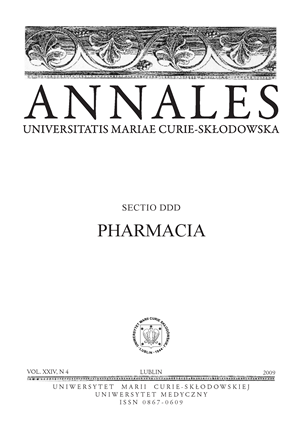Evaluation of usefulness of CA and PCA for identificationof incompatibilities in the pharmaceutical phase
Abstract
The objective of the study was an attempt to examine the usefulness of the most frequently used multivariate techniques in the pharmaceutical analysis such as cluster analysis (CA) and principal component analysis (PCA), as the supporting methods for identification of the physicochemical incompatibility occurring between drugs and excipients. The binary physical mixtures of acetazolamide, atenolol, baclofen, hydrocortisone and piroxicam with the excipients such as lactose, mannitol, methylcellulose, starch, magnesium stearate and talc, mixed in the molar or mass ratios of 9:1, 7:3, 1:1, 3:7 and 1:9, were studied. The possibility of incompatibilities between both components of the mixtures under study was investigated based on the results obtained with the help of differential scanning calorimetry (DSC), differential thermal analysis (DTA), thermogravimetry (TG) as well as infrared spectroscopy (IR) and hot-stage microscopy (HSM). The obtained results were interpreted with the help of chemometric techniques. Based on these results it can be shown that the physicochemical incompatibilities in the binary physical mixtures of acetazolamide with lactose, mannitol, methylcellulose, starch and baclofen with lactose, magnesium stearate are probable. It was confirmed by the results of the statistical analysis which showed that CA and PCA techniques are very helpful in the interpretation of thermoanalytical data.
References
1. British Pharmacopoeia, Vol. 1 and 3, The Stationery Office, London 2004.
2. Burnham L., Dollimore D., Alexander K.S.: Kinetic study of the drug acetazolamide using thermogravimetry. Thermochim. Acta, 392, 127, 2002.
3. Drebushchak V. A., Shakhtshneider T. P., Apenina S. A. et al.: Thermoanalytical investigation of drug-excipient interaction. Part I. Piroxicam, cellulose and chitosan as starting materials. J. Therm. Anal. Cal., 84, 643, 2006.
4. Drebushchak V. A., Shakhtshneider T. P., Apenina S. A. et al.: Thermoanalytical investigation of drug-excipient interaction. Part II. Activated mixtures of piroxicam with cellulose and chitosan. J. Therm. Anal. Cal., 86, 303, 2006.
5. Freitas M. N., Alves R., Matos J. R., Marchett i J. M.: Thermal analysis applied in the osmotic tablets pre-formulation studies. J. Therm. Anal. Cal., 87, 905, 2007.
6. Hill T., Lewicki P.: Statistics, methods and applications. A comprehensive reference for science, industry, and data mining. StatSoft, Inc., Tulsa 2006.
7. Karta charakterystyki substancji niebezpiecznej z dnia 10.01.2007 (Card of profile of dangerous substance), Talc, Pharma Cosmetic.
8. Kibbe H.: Handbook of pharmaceutical excipients, 3rd ed., Amer. Pharm. Assoc. Pharm. Press, London-Washington 2000.
9. Lira A. M., Araújo A. A. S., BasílioI. D.J. et al.: Compatibility studies of lapachol with pharmaceutical excipients for the development of topical formulations. Thermochim. Acta, 457, 1, 2007.
10. Lund W.: The Pharmaceutical Codex, 12th ed., The Pharmaceutical Press, London 1994.
11. Marini A., Berbenni V., Moioli S. et al.: Drug-excipient compatibility studies by physicochemical techniques. The case of indomethacin. J. Therm. Anal. Cal., 73, 529, 2003.
12. Marini A., Berbenni V., Moioli S. et al.: Drug-excipient compatibility studies by physicochemical techniques. The case of atenolol. J. Therm. Anal. Cal., 73, 547, 2003.
13. Otto M.: Chemometrics. Statistics and computer application in analytical chemistry. Wiley-VCH, New York 1999.
14. Polish Pharmacopoeia, 6th ed., PTFarm, Warsaw 2002.
15. Pyramides G., Robinson J. W., Zito S. W.: The combined use of DSC and TGA for the thermal analysis of atenolol tablets. J. Pharm. Biomed. Anal., 13, 103, 1995.
16. Rezende R.L.O., Santoro M.I.R.M., Matos J. R.: Stability and compatibility study on enalapril maleate using thermoanalytical techniques. J. Therm. Anal. Cal., 93, 881, 2008.
17. The United States Pharmacopoeia, USP 30. The National Formulary NF 25, Vol. 3, The US Pharmacopeial Convention, Rockville 2006.
18. Wesołowski M.: Pattern recognition methods and artificial neural networks in pharmaceutical analysis. Annales UMCS, Sec. DDD, 19, 63, 2006.
19. Wesołowski M., Konieczyński P.: Thermoanalytical, chemical and principal component analysis of plant drugs. Int. J. Pharm., 262, 29, 2003.
20. Wesołowski M., Szynkaruk P.: Thermal decomposition of methylxanthines. Interpretation of the results by PCA. J. Therm. Anal. Cal., 93, 739, 2008.
Downloads
Published
Issue
Section
License
Copyright (c) 2009 Authors

This work is licensed under a Creative Commons Attribution-NonCommercial-NoDerivatives 3.0 Unported License.


